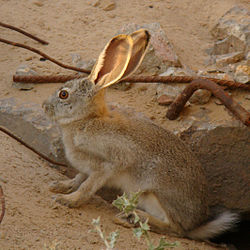| Tolai hare | |
|---|---|
 | |
| Scientific classification | |
| Domain: | Eukaryota |
| Kingdom: | Animalia |
| Phylum: | Chordata |
| Class: | Mammalia |
| Order: | Lagomorpha |
| Family: | Leporidae |
| Genus: | Lepus |
| Species: | L. tolai |
| Binomial name | |
| Lepus tolai Pallas, 1778 | |
 | |
| Tolai hare range | |
The tolai hare (Lepus tolai) is a species of hare native to Central Asia, Mongolia, and Northern and Central China. It inhabits semi-desert, steppes, rocky habitats, and forest meadows. It is relatively common, even in areas with heavy human disturbance, due to its fast reproductive rate. It is mainly active at dusk and at night but is occasionally active during the day. [2]

